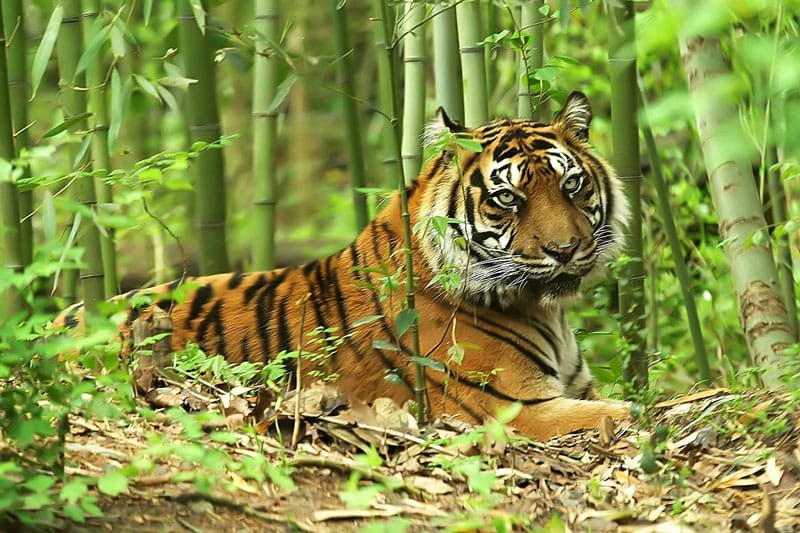
Sumatran tigers are not just another subspecies; they are the last of their kind in Indonesia. With striking orange coats and bold black stripes, they’re the smallest, but they carry an immense importance in the ecological balance of their habitat. So, let’s dive deeper into where these magnificent creatures live, their habitats, and how they adapt to their surroundings.
The Unique Habitat of the Sumatran Tiger
Sumatran tigers thrive in a variety of habitats, but they typically prefer to live in tropical rainforests. These areas provide them with ample cover for both hunting and resting. The dense trees and underbrush are perfect for stalking prey, which mainly consists of animals like deer and wild boar. You might be wondering why they need such a specific environment. Well, it’s all about balance. The rainforest not only offers camouflage but is also teeming with the biodiversity that sustains their prey.
In addition to rainforests, Sumatran tigers can also be found in mangroves and swamp forests. These habitats are vital for their survival, providing essential resources such as water and food. Here, tigers can hunt for fish and other aquatic animals, broadening their diet. It’s fascinating to see how versatile these tigers are, adapting to different terrains while remaining the apex predators of their ecosystems.
Geographical Distribution in Sumatra
Sumatran tigers are endemic to the island of Sumatra, which is the only place in the world where they can be found in the wild. This island is characterized by its rich biodiversity and is covered with an intricate web of ecosystems. They roam primarily within two major national parks: Gunung Leuser National Park and Kerinci Seblat National Park. These protected areas are crucial for conservation efforts, limiting human encroachment and preserving the natural habitat.
Interestingly, the distribution of Sumatran tigers is not uniform across the island. Their range is often fragmented due to agriculture and development. This fragmentation limits their movements and genetic diversity, which can lead to serious issues in the long run. Conservationists are working hard to create wildlife corridors, ensuring these majestic animals have a chance to thrive despite the challenges posed by human activity.
The Impact of Climate and Geography
Climate plays a pivotal role in the Sumatran tiger’s habitat. The island experiences a tropical climate with heavy rainfall, especially during the monsoon season. This season helps keep the forests lush and green, providing an ideal environment for both the tigers and their prey. The variations in altitude also create different microhabitats, offering diverse food sources and shelter.
Geographically, Sumatra features impressive mountain ranges and lowland forests. Tigers often traverse different altitudes, allowing them to adapt to various conditions. For instance, during the hotter months, they might seek cooler areas in the highlands or thicker forest cover to avoid heat. This adaptability is vital for their survival, as it enables them to cope with changing environmental factors.
Human Impact on Sumatran Tiger Habitat
While Sumatran tigers have adapted to their habitats, human activities pose a significant threat to their survival. Deforestation for agriculture, logging, and urban development has led to substantial habitat loss. It’s a bit like slowly dismantling a puzzle—each piece taken away makes it harder for the others to fit together. As forests disappear, tigers are forced into smaller areas, which can lead to increased competition for food and territory.
Additionally, illegal poaching remains a critical risk. While hunting tigers directly is illegal, poachers often target their prey, disrupting the entire food chain. Less prey means that tigers struggle to find enough food, making survival more challenging. Conservation efforts are essential not only to protect these majestic animals but also to preserve their habitats from further degradation.
Conservation Efforts and Future Outlook
Conservationists are stepping up to protect Sumatran tigers and their habitats. Organizations are working tirelessly to create and enforce protected areas while also promoting sustainable land use practices. One vital initiative is the creation of wildlife corridors, allowing tigers to roam freely between fragmented habitats. This enhances genetic diversity, making the population more resilient.
Additionally, education and community involvement are crucial. Local communities are encouraged to participate in conservation efforts, which include sustainable agriculture practices that don’t encroach on tiger habitats. By creating economic incentives for protecting nature, we can foster a sense of stewardship and responsibility.
The future of Sumatran tigers hinges on these combined efforts. It’s a team game—conservationists, local communities, and even governments all play crucial roles in making sure these incredible creatures continue to roam the forests of Sumatra.
The habitat and distribution of Sumatran tigers reflect the intricate balance of nature and the direct consequences of human actions. These tigers are not just beautiful creatures; they are essential to the ecosystems they inhabit. By understanding where they live and the challenges they face, we can all play a part in their protection.
Every little effort counts—from supporting conservation organizations to spreading awareness about the importance of preserving their habitats. Together, we can ensure that future generations can also marvel at the majestic Sumatran tiger, roaming freely in the lush landscapes of Sumatra. Let’s make a commitment to protect their home and honor their place in our world.

